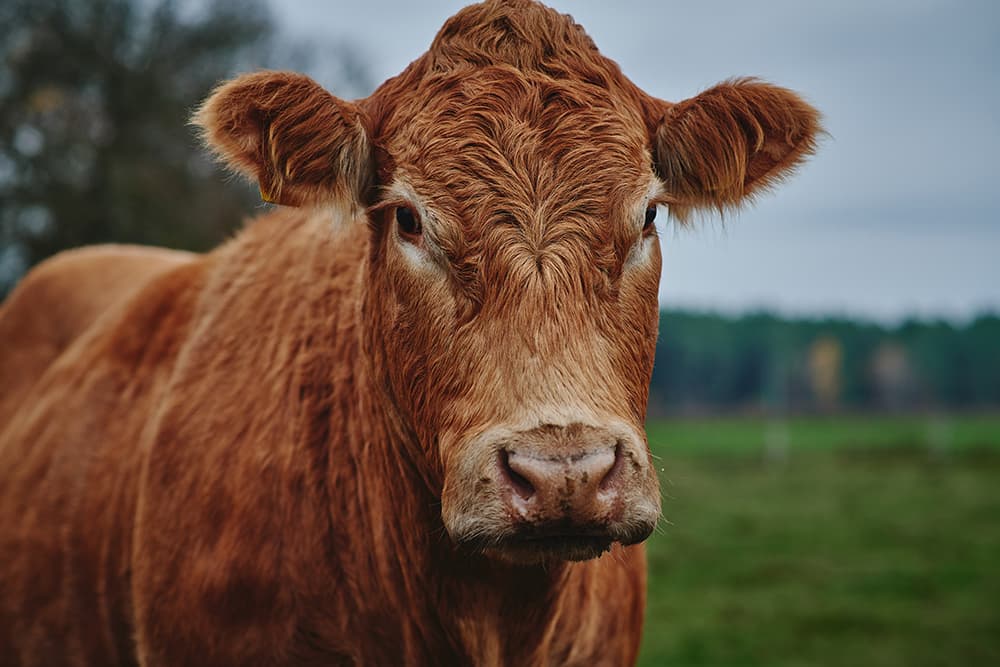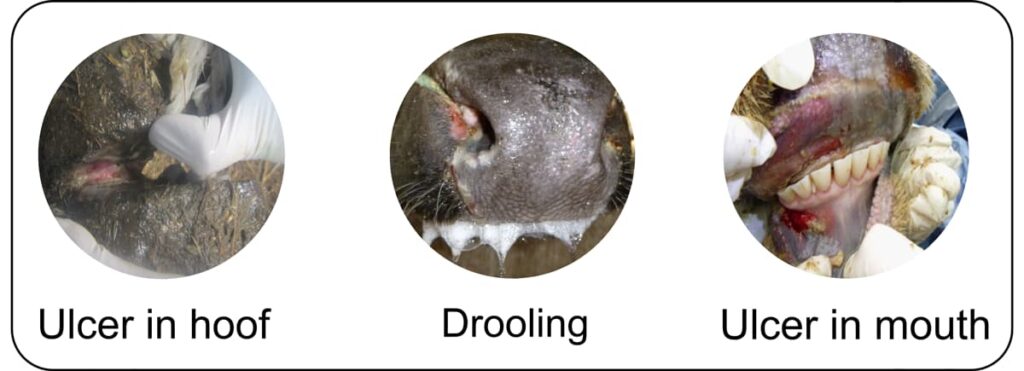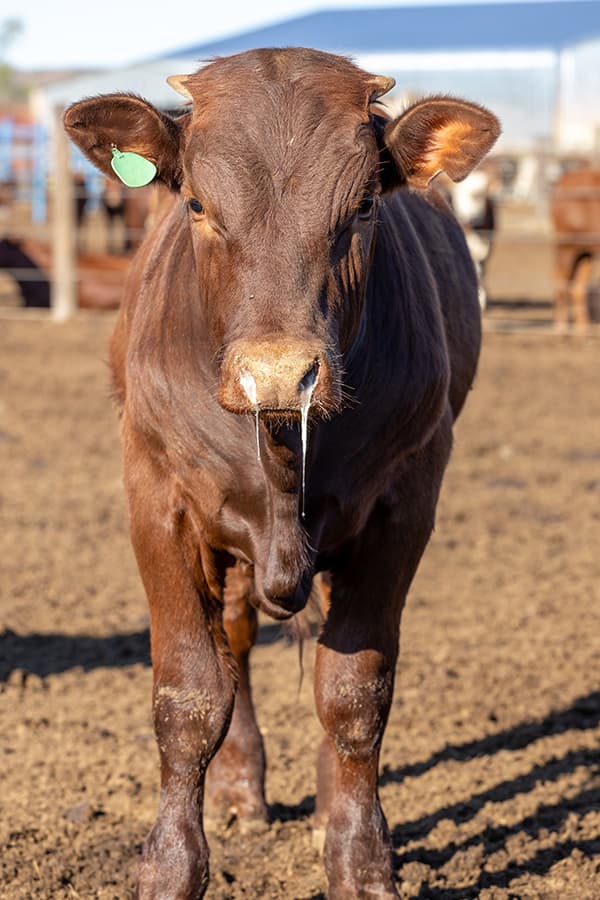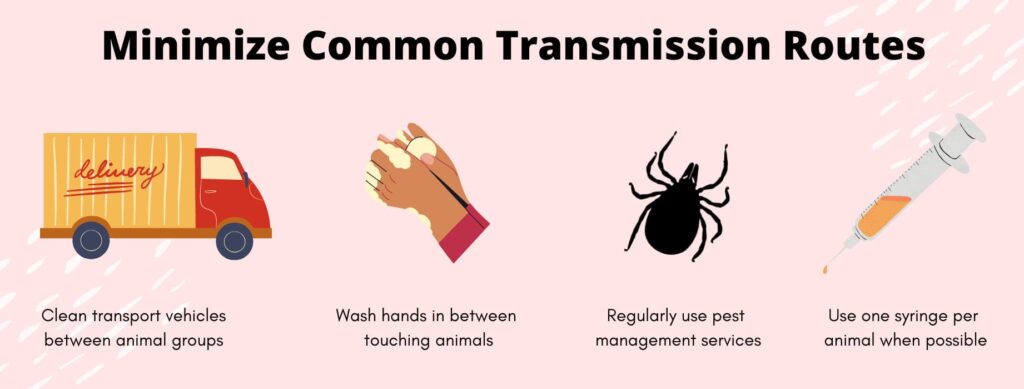Beef Cattle Diseases
Learn about a variety of cattle dieases and how to identify them
The United States is among the world’s largest beef producers and exporters, and the beef industry is a major contributor to the U.S. gross domestic product. U.S. beef cattle producers also spend significant money treating diseases while raising beef cattle. Understanding and identifying diseases will safeguard beef cattle and the industry against diseases and economic losses. The information in this section helps you better understand and identify important beef cattle diseases that pose a threat and/or are widespread in the U.S. beef cattle industry.
Overview
The United States tops the list of beef cattle-producing countries globally. The United States also is one of the world’s top beef cattle exporters. In 2021, this industry generated nearly $72 billion through selling meat and by-products, and $10 billion through exports. However, the U.S. beef cattle industry has multiple production sectors and is complex. It has incurred and could incur substantial losses due to outbreaks of foreign animal diseases and endemic diseases. Consequently, cattle producers and the beef cattle industry have an ongoing mental and financial burden.
For example, the United States and a few other countries have been free of foot and mouth disease (FMD) for more than 50 years. Any outbreaks in FMD-free countries would have a substantial and detrimental impact on agriculture, the food chain, and tourism. It may lead to the depopulation of beef cattle herds.
Other highly contagious cattle diseases, such as bovine viral diarrhea (BVD) and bovine respiratory disease complex (BRD), could disrupt the beef cattle market and lower the value of calves. In addition, endemic diseases on a farm indirectly affect the economy and animal health.
Strict farm-level biosecurity is the most important effort the United States can take to protect producers and the national economy from the serious consequences of these diseases.

Farm-level biosecurity safeguards the herd from foreign and endemic diseases and minimizes loss, as seen in the 2001 FMD outbreak in the United Kingdom. This event took the cattle industry by surprise, causing high fatalities in calves and disruptions to the supply chain.
To ensure that history does not repeat itself, producers and institutions must prepare for the worst-case scenario.
This module includes detailed descriptions of beef cattle diseases that either pose a threat or are widespread in the U.S. industry.
First, it is important to differentiate between healthy and sick cattle to effectively monitor herds and intervene when necessary.
Eyes
|
|
Ear
|
|
Nose
|
|
Body
|
|
Tail
|
|
Activity
|
|
Other symptoms
|
Foot and Mouth Disease
Foot and mouth disease (FMD) is a highly contagious viral disease caused by more than 80 subtypes of the FMD virus. It affects a wide range of cloven-hoofed wildlife and domestic animals, including beef cattle of all ages. The United States has been FMD-free since the 1929 outbreaks and does not vaccinate cattle against the disease. FMD is present in two-thirds of the world’s countries. So, there is a risk that FMD will reoccur in the United States if biosecurity is compromised, which could cost $12 billion to $18 billion to stamp out the disease.
FMD is not related to the hand, foot, and mouth disease found in humans and does not affect humans through direct contact or infected food such as milk or meat.
If an FMD outbreak struck a farm, it could quickly spread across multiple farmers. The resulting loss of cattle would lead to huge production and economic loss for the farmers. It also would affect the meat supply within the country and international exports of meat, meat products, and meat byproducts.

Photo provided by Rima Shrestha
Sign and Symptoms
- Fever above 40.5ºC or 105ºF
- Vesicles or blister-like sores on the tongue and lips, in the mouth, on the teats, and between and around the hooves. Vesicles usually burst within 24 hours, causing ulcers/erosions.
- Sudden lameness or reluctance to move or stand
- Drooling or excessive salivation
- Lack of appetite
- Rapid fall in milk production
- Pregnant cows may abort
- Calves may die suddenly due to inflammation of the heart muscle
Risk Factors
FMD can spread within and between cattle with the movement of infected animals or through contaminated vehicles, equipment, people, and animal products. The virus can also spread by wind up to several miles or via contaminated semen. It also can remain infectious in animal beddings, manure, straw, and hair for a long time.

FMD can spread in many ways, including contaminated vehicles, people, other animals, and bedding, as well as by wind.
How to Protect Your Herd
There is no approved treatment for FMD. Vaccinations against FMD are based on the types of virus in a region or country. Therefore, vaccinations are only available in countries where FMD is present. These vaccines are not effective in preventing the disease in FMD-free countries.
Implementing farm-level biosecurity is the best way to prevent a herd from getting infected. Proven biosecurity measures include:
- Prohibiting unauthorized people’s access to the farm, farm equipment, and livestock.
- Not permitting visitors with a history of international travel, especially to countries with FMD.
- Maintaining a visitor log and only allowing authorized people on the farm.
- Only buying beef cattle that have been tested and certified.
- Quarantining new livestock before mixing them with existing herds.
- Restricting animal and human movement within and between ranches.
- Reducing contact with large wild animals by fencing the farm.
- Cleaning and disinfecting equipment and transportation vehicles after use.
- Cleaning and disinfecting pens thoroughly between beef cattle groups.
- Implementing rodent and other pest control on the farm.
- Setting up a shower-in and shower-out system for people allowed on the farm.
- Requiring farm-specific clothing and boots to be worn by people on the farm.
- Avoid importing live cattle or cattle feed from regions or countries where FMD is present.
- Not feeding cattle food products that are meant for human consumption, including food waste from restaurants or domestic kitchens.
- Routinely testing and monitoring herds for FMD.
- Consulting veterinarians when you see symptoms of FMD.
- Isolating sick cattle from healthy ones.
- Disposing of manure and carcasses appropriately.
Bovine Viral Diarrhea (BVD)
Bovine viral diarrhea (BVD) is an important viral disease that affects cattle and other livestock with severe economic consequences for the cattle industry. It is caused by the bovine viral diarrhea virus (BVDV). BVD mainly affects the immune system and reproduction of cattle. Cattle of all ages are susceptible to BVDV infection.
BVDV can cause mucosal diseases, persistent low-grade infections, brief severe infections, or, in rare instances, longtime severe infections. Persistently infected cattle can shed more viruses for longer periods than acutely infected cattle. There is a wide range of symptoms, such as diarrhea, infertility, abortion, and fetal abnormality.
Because many herds infected with BVDV don’t show any symptoms, the production losses from BVD, such as reduced reproduction and calf growth, are underestimated. Beef cattle producers incur billions of dollars in losses each year to persistently shed BVDV.
Sign and Symptoms
- In calves:
- Stumbling, weaving, and toe dragging
- Tremors
- Wide stances
- In adult cattle:
- Difficulty breathing
- Sudden fever
- Nasal discharge
- Discharge from eyes
- Lesions on mouth and throat
- Diarrhea
- Decreased milk production
- Loss of appetite
- Abortions
- Blood disorders, such as bleeding from wounds or lesions, destruction of red blood cells, or reduced clotting.
Risk Factors
BVD can easily be transmitted through contact with infected or persistently infected (carrier) animals. In addition, indirect contact with contaminated water buckets, calf feeders, feed bunks, IV equipment, nose leads, clothing, or people and cattle trucks can transmit BVDV within or between herds.
How to Protect Your Herd
Vaccination and biosecurity are recommended to protect cattle herds from infection and eliminate BVD. In addition to maintaining a strong BVDV vaccination program, proven biosecurity measures include:
- Immediately removing calves born from cows exposed to BVDV during the last 125 days of pregnancy from the herd.
- Testing all newborn calves.
- Stopping or restricting the purchase of replacement animals through an auction market.
- Testing new animals before introducing them into a herd.
- Only buying vaccinated animals (with documentation) or vaccinating new animals for at least two weeks before adding them to a herd.
- Purchasing artificial breeding services from certified organizations.
- Maintaining a closed herd.
- Disinfecting farm equipment.
- Cleaning animal sheds and feeders.
- Moving animals with your trucks.
Bovine Respiratory Diseases
Bovine respiratory disease complex (BRD), or shipping fever, is an important and costly infectious respiratory disease of beef cattle in North America.
BRD is considered a disease complex because different pathogens singly or in combination cause this disease. BRD is the leading cause of illness and death in cattle and can affect cattle of any age and breed. Nearly 20% of beef cattle require BRD treatment, resulting in about $1 billion in losses from reduced production and treatment costs.
BRD can be caused by viruses such as bovine respiratory syncytial virus (BRSV), bovine herpesvirus type 1 (BOHV-1), bovine viral diarrhea virus (BVDV), and parainfluenza‐3 virus (PI‐3) as well as bacteria such as Pasteurella multocida, Histophilus somni, Mannheimia hemolytica, and Mycoplasma bovis.
Sign and Symptoms
- Difficulty breathing
- Coughing
- Watery, bloody, or puss discharge from the nose or eyes
- Salivation
- Reduced or no appetite
- Fever over 40°C (104°F)
- Depression
- Rapid, shallow breathing

Risk Factors
The biggest risk for BRD getting onto a farm is contact with new animals, including infected cows, calves, leased bulls, neighbor cattle, and replacement heifers. Other risk factors are visitors, suppliers, feed, and wildlife.
How to Protect Your Herd
Generally, airborne viruses can be transmitted more than 12 feet from their primary source. Because BRD is complex, using a combination of strategies is suggested to combat this significant disease in beef cattle ranches.
Proven biosecurity measures that can reduce exposure to new BRD pathogens include:
- Adding only vaccinated animals to the farm.
- Purchasing new animals from uninfected herds.
- Quarantining new animals for a minimum of 14 days before adding them to your herd.
- Testing new animals for pathogens that cause BRD infections.
- Isolating sick animals to reduce shedding pathogens to the other animals.
- Preventing contact with neighboring cattle.
- Avoid overstocking.
- Improving the immune system of herds with effective vaccination programs, minimizing herd and heat stress, providing good nutrition, deworming, and treating affected animals immediately.
- Cleaning and disinfecting equipment and housing areas.
Infectious Bovine Rhinotracheitis
Infectious bovine rhinotracheitis (IBR) is an acute and highly contagious viral respiratory disease of cattle in the United States and other major cattle-producing countries. Bovine herpesvirus type 1 (BOHV-1) causes this disease, which commonly affects the respiratory tract and reproductive system.
IBR affects all ages of cattle and spreads rapidly among cattle in close confinement, particularly in feedlots and during transport. Both asymptomatic and clinically affected animals spread the IBR virus through direct contact, nasal discharge, coughing, and the semen of infected bulls. The virus also can be spread by feed and water that has been contaminated by secretions of diseased cattle.
The persistent presence of IBR on farms leads to several problems such as pneumonia in calves and decreased fertility and occasional abortions in cows.
Sign and Symptoms
- Difficulty breathing
- Sudden onset of fever
- Red nose
- Nasal discharge
- Salivation
- Changes in the nose, mouth color (red), and swelling
- Mucosal lesions
- Pink eye
- Lack of appetite
Risk Factors
- Adding new animals to the farm
- Direct contact (nose-to-nose) between infected and noninfected cattle
- Farm personnel, visitors, and equipment
- Contaminated semen
- Latent virus carriers
How to Protect Your Herd
Because there is no specific treatment for BOHV-1, vaccinations and preventing the virus from getting into ranches are critical for the prevention and control of IBR. Nasal vaccines are effective as soon as 24 hours after they are administered.
Proven biosecurity measures that can help keep the virus from getting on farms include:
- Only adding vaccinated animals to herds.
- Buying new animals from uninfected or certified IBR-free herds.
- Quarantining new animals for a minimum of 14 days and testing them for IBR antibodies before adding them to herds.
- Limiting access to essential visitors and disinfecting their protective clothing and equipment.
- Testing blood regularly to detect and remove virus-carrier cattle.
- Vaccinating the herd.
Other Important Cattle Diseases
In the previous sections, we overviewed important diseases that can or are causing severe production and financial loss in the beef industry. Other economically important infectious diseases may affect the productivity and health of herds.
Anthrax is a highly contagious and fatal disease for humans and animals. Bacillus anthracis bacteria cause this disease through ingestion or inhalation of bacterial spores. This bacterium can persist in the environment for a long time. Anthrax outbreaks were reported in the West (the latest in 2022 in sheep in Texas) and Midwest regions (the latest in 2022 in cattle in South Dakota) of the United States. Veterinarians or animal health officials must be notified immediately if you find bloated cattle with bloody discharge from body openings and no rigor mortis. Yearly vaccinations are critical to preventing this disease.
Bovine spongiform encephalopathy (BSE), also known as “mad cow disease,” affects cattle aged 5 years or older. It is a fatal nervous system disease related to a rare human disease called variant Creutzfeldt-Jakob Disease. Cattle infected with BSE take two to eight years to show symptoms. BSE has been reported sporadically in the United States. Because vaccines are not available for this disease and it can only be detected in tests on dead cattle, the only safeguard is preventing the transmission of BSE.
Brucellosis is a contagious bacterial disease that has been eradicated from most livestock in the United States, but it has been found in wild animals such as elk and bison. It is also known as contagious abortion or Bang’s disease. This disease affects both males and females and causes abortion in pregnant females, leading to infertility, loss of productivity, and severe economic burden. Directly or indirectly, infected animals can transmit brucellosis to other animals and humans. Testing herds for brucellosis at the slaughterhouse and in the auction market is needed before cattle are introduced to new herds.
Bovine tuberculosis (TB) is another contagious bacterial disease that is rare in the United States. TB can spill over from wild animals (e.g., deer and elk) and may also infect humans. It can be transmitted through the air or by eating contaminated feed or water. Therefore, any new animals should be tested for TB before introducing them to your herds.
Johne’s disease (paratuberculosis) is an often costly bacterial disease that is transmitted through feed, water, or milk. It causes chronic intermittent diarrhea, which is hard to treat, and no cure is available. Cattle do not show symptoms but may continually lose weight despite having a good appetite. Voluntary risk management programs are available for producers to help them monitor this disease.
Leptospirosis, screwworm infection, bovine trichomonosis, anaplasmosis, and vesicular stomatitis are examples of bacterial, protozoal, and viral diseases to watch for while running farms. These diseases can be found in some swampy areas of farms and can be transmitted through direct or indirect contact. These diseases can greatly harm cattle’s health through sores, vomiting, other indications of bodily pain, reduced weight gain, reproductive issues, and high mortality. Strict biosecurity measures often help prevent the transmission of these diseases.
Possible Routes of Transmission

Minimize the risk of transmitting disease through direct and indirect ways.
Direct transmission
- Direct/close contact with sick animals (nuzzling, huddling)
- Bodily fluids or droplets transmitted via air (snot, eye discharge, saliva)
- Contaminated feces/urine
- Mating with a sick animal
- Contaminated colostrum (cow to calf)
Indirect transmission
- Using the same syringe on two or more animals
- Animals using contaminated bedding
- Animal handlers not washing and disinfecting their hands between handling sick animals
- Contaminated/dirty transport vehicles
Vector-borne transmission
- Ticks, mosquitoes, and fleas transmit diseases among animals
What’s Next?
Now that you are familiar with some of the important diseases that claim millions of cattle every year, let’s learn about the ways we can protect our herd against them through Biosecurity.
